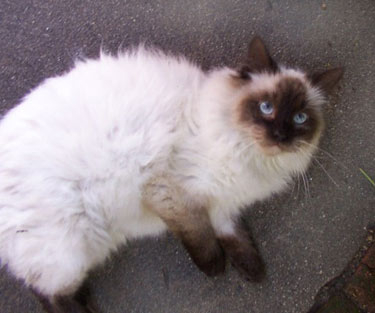
 |
| Home Cats Dogs Horses Groups Resources Contact |
Domestic Cat Rescue and Adoption
United States
AZ: Arizona Cat Rescue United KingdomCats Protection, Sussex CanadaBC: Prince George Animal Rescue, Prince George Cat Breed InformationDeclawing, Effective AlternativeSoft Paws, Nail Caps for Cats and Dogs |
Feral Cat Organizations and Care
Feral is another term for stray or alley cat. A pet cat is very tame and is called a domestic cat. If domestic cats are abandoned, they revert back to natural instincts in order to survive. Once they have kittens and raise those kittens in nature, away from human contact, the kittens (who know nothing other than its mother's survival teachings) are known as feral (which means wild). Feral cats are afraid of humans, just as most wild animals are. If fed and taken care of by humans, they can eventually become more relaxed around them, just as bears, raccoons or squirrels become accustomed to human contact if fed on a regular basis. You cannot pick up a feral without getting scratched and bitten, just as you would not pick up a squirrel or pet a bear that came up to you for a treat without the consequences of getting bitten or scratched. With enough time, gentle treatment, and patience, it is possible to tame a feral, just as trainers are eventually able to tame bears and other wildlife. Ferals have become an increasing problem in the United States and ideas on how to cut back the feral population varies. Most feral cats live in groups called colonies. Currently, it is believed the best way is to decrease the population is to capture the ferals using a humane trap (such as those carried by Havahart.com), to have them spayed or neutered and vaccinated by a feral cat friendly veterinarian, and then returned to their colonies (or the place where they were captured). The theory is that once the ferals are unable to reproduce, the colonies will eventually die off. There are many feral cat organizations which offer vouchers for discounts on surgery to sterilize (fix) these cats. You may be able to find a list of veterinarians who will spay/neuter ferals by contacting your local shelter or by contacting a feral cat organization in your area. Below are feral cat resources for anyone interested in helping out. Most are run by volunteers who donate their time and are always happy to have help. |
Feral Cat Humane TrapsHavahart Pet Supplies: Feral Cat Traps Feral Cat OrganizationsUnited States
CA: Feral Cat Foundation EuropeUK, Billingshurst, Sussex: Caring for Cats |
Rescue Centers © 2005-2025 Heidi Bosch Romano.
All rights reserved.